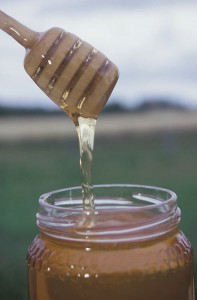So You Think You’re Eating Honey
 If you’re eating local, farmers market, or health food store honey, you may actually be eating honey, but, if you’re eating supermarket honey or McDonald’s packet honey, it may not be real honey. Honey, especially honey imported from China, is often ultra-filtered, “a high-tech procedure where honey is heated, sometimes watered down and then forced at high pressure through extremely small filters to remove pollen, which is the only foolproof sign identifying the source of the honey.” [Sounds a lot like the extreme process commercial milk goes through, doesn’t it?] “Food Safety News decided to test honey sold in various outlets after its earlier investigation found U.S. groceries flooded with Indian honey banned in Europe as unsafe because of contamination with antibiotics, heavy metal and a total lack of pollen which prevented tracking its origin.” The Indian honey was primarily honey imported from China and routed through India to get around the import regulations.
If you’re eating local, farmers market, or health food store honey, you may actually be eating honey, but, if you’re eating supermarket honey or McDonald’s packet honey, it may not be real honey. Honey, especially honey imported from China, is often ultra-filtered, “a high-tech procedure where honey is heated, sometimes watered down and then forced at high pressure through extremely small filters to remove pollen, which is the only foolproof sign identifying the source of the honey.” [Sounds a lot like the extreme process commercial milk goes through, doesn’t it?] “Food Safety News decided to test honey sold in various outlets after its earlier investigation found U.S. groceries flooded with Indian honey banned in Europe as unsafe because of contamination with antibiotics, heavy metal and a total lack of pollen which prevented tracking its origin.” The Indian honey was primarily honey imported from China and routed through India to get around the import regulations.
Food Safety News purchased more than 60 jars, jugs, and plastic bears of honey. The contents were analyzed by Professor Vaughan Bryant at Texas A&M University. Here’s a summary of the Dr. Bryant’s results:
• 76 percent of samples bought at groceries had all the pollen removed, These were stores like TOP Food, Safeway, Giant Eagle, QFC, Kroger, Metro Market, Harris Teeter, A&P, Stop & Shop and King Soopers.
• 100 percent of the honey sampled from drugstores like Walgreens, Rite-Aid and CVS Pharmacy had no pollen.
• 77 percent of the honey sampled from big box stores like Costco, Sam’s Club, Walmart, Target and H-E-B had the pollen filtered out.
• 100 percent of the honey packaged in the small individual service portions from Smucker, McDonald’s and KFC had the pollen removed.
• Bryant found that every one of the samples Food Safety News bought at farmers markets, co-ops and “natural” stores like PCC and Trader Joe’s had the full, anticipated, amount of pollen.
As noted in the last bullet, there is some good news: all samples “bought at farmers markets, co- ops and ‘natural’ stores” contained pollen. At the major grocery stores you’re more likely to get real honey by buying organic—71% were heavy with pollen. According to Mark Jensen, president of the American Honey Producers Association, “removal of all pollen from honey “makes no sense” and is contrary to marketing the highest quality product possible.” “I don’t know of any U.S. producer that would want to do that. Elimination of all pollen can only be achieved by ultra-filtering and this filtration process does nothing but cost money and diminish the quality of the honey.” The pollen is filtered out of the honey to hide its source, which is usually China.
The discovery of fake honey is just another good reason to know your farmer. Buy local raw honey from a farmer you know and can ask how he processes his honey.
If you still buy store brands of honey, the Food Safety News article has a long list of the honey brands that were found to contain NO pollen, and were, therefore, over heated and highly processed, probably even watered down and contaminated. There’s another way to find out what kind of honey you’re eating, or if you’re eating honey at all: to to True Source Honey.
Sources:
Tests Show Most Store Honey Isn’t Honey
What Passes For Honey on U.S. Shelves
Honey laundering: When honey isn’t really honey

Comments
So You Think You’re Eating Honey — No Comments
HTML tags allowed in your comment: <a href="" title=""> <abbr title=""> <acronym title=""> <b> <blockquote cite=""> <cite> <code> <del datetime=""> <em> <i> <q cite=""> <s> <strike> <strong>